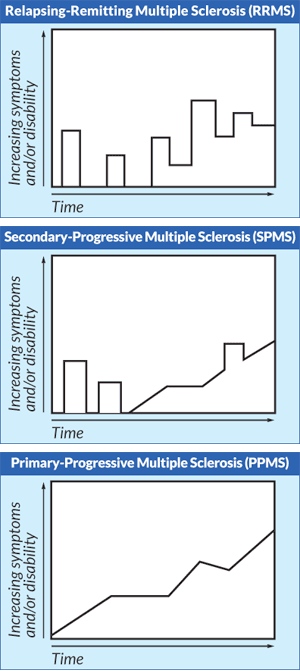Multiple sclerosis: what are the different types of the disease?
Published May 30, 2022 • By Candice Salomé
Multiple sclerosis (MS) is an autoimmune disease that affects the central nervous system and causes mobility impairments, sensory, visual and cognitive disorders and sphincter dysfunction.
It is estimated that nearly 1 million people live with multiple sclerosis in the United States.
There are three main types of multiple sclerosis, the development of each of them varies considerably from one patient to another.
So what are the types of multiple sclerosis? What are their symptoms and how do they progress?
We explain it all in our article!

Multiple sclerosis exists in several forms that vary according to the speed of the disease progression and the presence or absence of relapses.
There are three main types of multiple sclerosis. The development of each of these types can vary greatly from one patient to another.
Relapsing-remitting MS (RRMS)
The relapsing-remitting form of MS affects 80% of patients at the onset of the disease. It mostly affects young women in their 20s and 30s, with a ratio of 3 women to 1 man.
This form of MS is characterized by acute but infrequent relapses, with intervals ranging from a few months to several years; these periods of relapses are interspersed with periods of complete (no symptoms at all) or partial remission. Recovery between relapses may be complete or may give way to persistent disorders.
Relapses of the relapsing-remitting form may last from a few hours to a few days.
Common symptoms of RRMS relapses include:
- Fatigue,
- Numbness,
- Visual disturbances,
- Spasticity or stiffness,
- Bowel problems,
- Bladder problems.
RRMS requires a general approach to disease management, combining medicinal and non-medicinal treatments such as rehabilitation, pain management, spasticity management, etc. Basic treatments allow to reduce the frequency of relapses and slow down the progression of disability.
Secondary progressive MS (SPMS)
In 50% of cases, relapsing-remitting multiple sclerosis (RRMS) progresses to a secondary progressive form (SPMS) within 5 to 20 years. The secondary progressive type of MS is characterized by a more continuous progression of the disease with fewer or no relapses, which leads to a gradual worsening of neurological damage and finally, to disability.
The signs that indicate the transition from RRMS to SPMS are subtle and are quite difficult to identify because of their daily variability, periods of more or less long stability known as "plateaus", because of the effects of symptom management or due to the different interpretation of clinical signs.
The diagnosis of secondary progressive multiple sclerosis is often made quite late. Indeed, for all the reasons mentioned above, and in the absence of validated biological or medical imaging markers of disease progression, patients usually experience a period of uncertainty that lasts about 3 to 4 years.
Nevertheless, new approaches are currently being offered to RRMS patients, to allow earlier identification of disease progression to SPMS and a better disease management.
The most common symptoms that can warn about the progression of multiple sclerosis are:
- The onset or worsening of walking or balance problems,
- Muscle weakness,
- Sensory problems,
- Cognitive or visual disturbances,
- Urinary problems.
In order to identify the transition to SPMS as early as possible, health professionals should search for the cause of the disease by asking patients and their carers very specific questions about their neurological condition and their functioning in their daily life, and by carrying out a clinical examination that includes walking tests or physical disability assessments, the results of which can then be compared with the results of previous assessments.
Primary progressive MS (MMPS)
Primary progressive multiple sclerosis (PPMS) affects 10-15% of patients at the onset of the disease. This rarer form of multiple sclerosis appears around the age of 40 and affects both men and women.
PPMS is a disabling form of the disease, marked by a regular worsening of symptoms. It usually progresses without a distinct relapse or remission period. In rare cases, however, patients may still experience relapses.
Primary progressive multiple sclerosis tends to be more disabling than the relapsing-remitting form. Indeed, the development of irreversible disability is twice as high for this form of MS than for RRMS. This means that patients with PPMS often have a greater need for mobility aids and wheelchairs.
The most common symptoms of PPMS include:
- Progressive generalized weakness,
- Mobility impairments,
- Spasticity.
These symptoms are not specific to PPMS, but they are more persistent and more difficult to manage than in other forms of MS.
Whatever the type of MS, there exist different criteria for defining the disease activity and monitoring its progress. The existence of relapses, progression of the expanded disability status scale (EDSS) score (a score used to rate disability), and the appearance of new lesions that can be visualized on MRI are recognized as markers of the disease activity. Patients with PPMS may also experience cognitive and speech problems, which are rare in RRMS.

Source: Multiple Sclerosis Association of America
Regular monitoring of the disease activity is essential in order to provide appropriate care, control the disease progression and delay the onset of disability.
Give it a "like" and share your thoughts and questions with the community in the comments below!
Take care!
Sources :
La sclérose en plaques : une seule maladie mais des formes différentes, Roche
La sclérose en plaques, Ministère des Solidarités et de la Santé
Les différentes formes de sclérose en plaques (SEP), SEP-Ensemble
Sclérose en plaques (SEP), INSERM
Formes de sclérose en plaques : quelles sont les similarités et les différences ?, Roche
Du nouveau pour repérer la transition à partir de la forme récurrente-rémittente, Edimark

 Facebook
Facebook Twitter
Twitter
